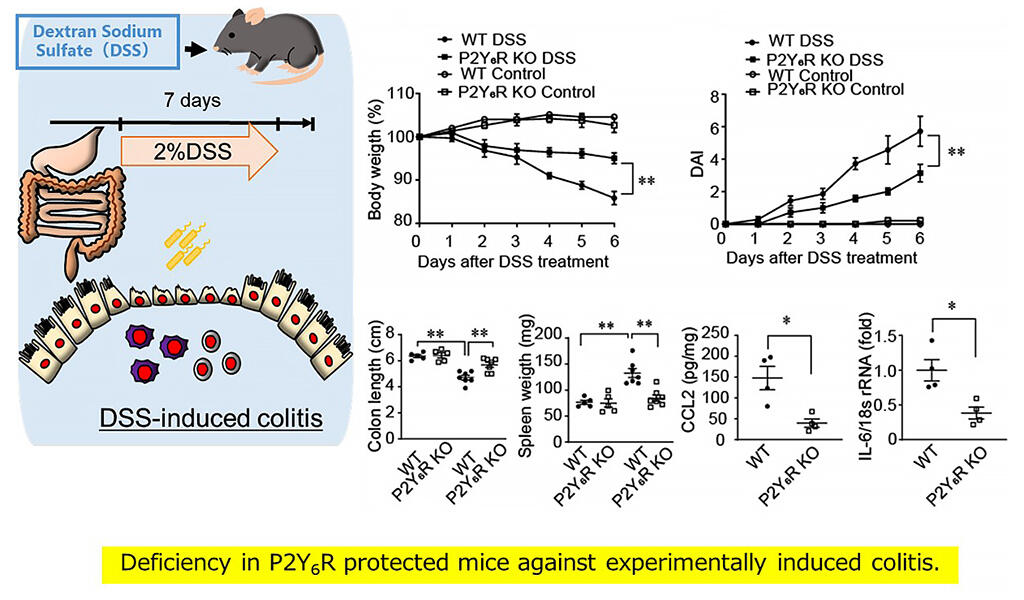A disruption of diet and lifestyle habits, stress, and other factors may trigger a collapse of the intestinal mucosal barrier, causing colitis, and resulting in symptoms such as diarrhea, bloody stool, and abdominal pain, in individuals with inflammatory bowel disease (IBD). IBD is an intractable disorder of unknown cause that may repetitively go into remission and relapse, even if steroids are administered, or the affected area is removed. There is, therefore, no radical cure. In joint research with the Exploratory Research Center on Life and Living Systems, Tohoku University, University of Tsukuba, Osaka Prefecture University, Tokyo Institute of Technology, and University of Tokyo, Professor Motohiro Nishida and Lecturer Kazuhiro Nishiyama of the Graduate School of Pharmaceutical Sciences at Kyushu University, found that P2Y6R, a G-protein coupled receptor (GPCR), is an exacerbating factor for IBD. They also discovered a novel "redox-dependent internalization mechanism" of taking up GPCR into cells for degradation. Lecturer Nishiyama said, "We found that P2Y6R is taken up into cells and degraded intracellularly as a result of the binding of an isothiocyanate compound to the cysteine residue at position 220 of P2Y6R. We hope to develop therapeutic drugs that target P2Y6R for inflammatory bowel disease or heart failure and to develop other drugs using the redox-dependent internalization mechanism." Their findings were published in the online version of Science Signaling.
The research group had previously shown that the expression of P2Y6R increases with age and is involved in the development of hypertension and heart failure. In this study, wildtype and P2Y6R-deficient mice were compared after they had been treated with dextran sulfate sodium (DSS) to cause colitis. Results revealed that symptoms of weight loss, bloody stools, and diarrhea due to DSS-induced colitis were mild in the P2Y6R-deficient, knockout mice. Therefore, they concluded that P2Y6R is an exacerbating factor of IBD.

Provided by Kyushu University
Next, they focused on the chemical structure of MRS2578, a P2Y6R inhibitory compound, and found that, at both ends, the isothiocyanate (ITC) group exercised an inhibitory effect. Isocyanate compounds are contained in food ingredients, such as iberin in cabbage and sulforaphane in broccoli sprouts. The research group found that the direct application of sulforaphane to cells results in the translocation of P2Y6R from the cell membrane surface to the intracellular space for degradation.
Regarding the intracellular uptake mechanism of GPCR, Professor Robert Lefkowitz and colleagues discovered a β-arrestin-mediated pathway. However, some GPCRs are less sensitive to β-arrestin, suggesting that there are other uptake mechanisms. In this study, the research group used β-arrestin-hyposensitive P2Y6R and demonstrated that the binding of the ITC group to the SH group of cysteine (Cys220) in the third intracellular loop of P2Y6R induced ubiquitination of lysine (Lys137) in the second loop. In comparison to the wildtype mice, the progression of colitis was promoted in the mutant mice in which the Cys220 of P2Y6R was replaced with serine (C220S). This mechanism of internalization/degradation via Lys-ubiquitination by Cys-modification was named redox-dependent alternative internalization (REDAI). REDAI was found to be conserved in GPCRs other than in P2Y6R, such as GPR15 and T2R19.
These results indicate that increased signals due to excessive expression of P2Y6R may lead to the progression of IBD pathology. Furthermore, the research group also found that sulforaphane and other compounds contained in functional foods degrade P2Y6R via the REDAI system, suppressing inflammation.
The results of this study are expected to lead to the development of therapeutic drugs targeting P2Y6R for IBD or heart failure, as well as the development of therapeutic methods and medications for other diseases using the REDAI system. In addition, since the REDAI system is a mechanism common to receptors that control taste and smell, in addition to P2Y6R, their discovery may lead not only to the prevention and treatment of inflammation but also to the clarification of the mechanisms of taste and smell abnormalities, which are caused by the novel coronavirus disease.
This article has been translated by JST with permission from The Science News Ltd.(https://sci-news.co.jp/). Unauthorized reproduction of the article and photographs is prohibited.




